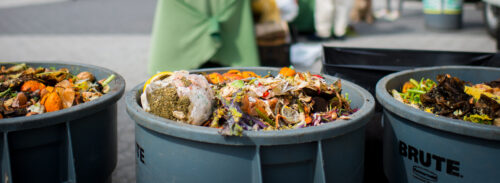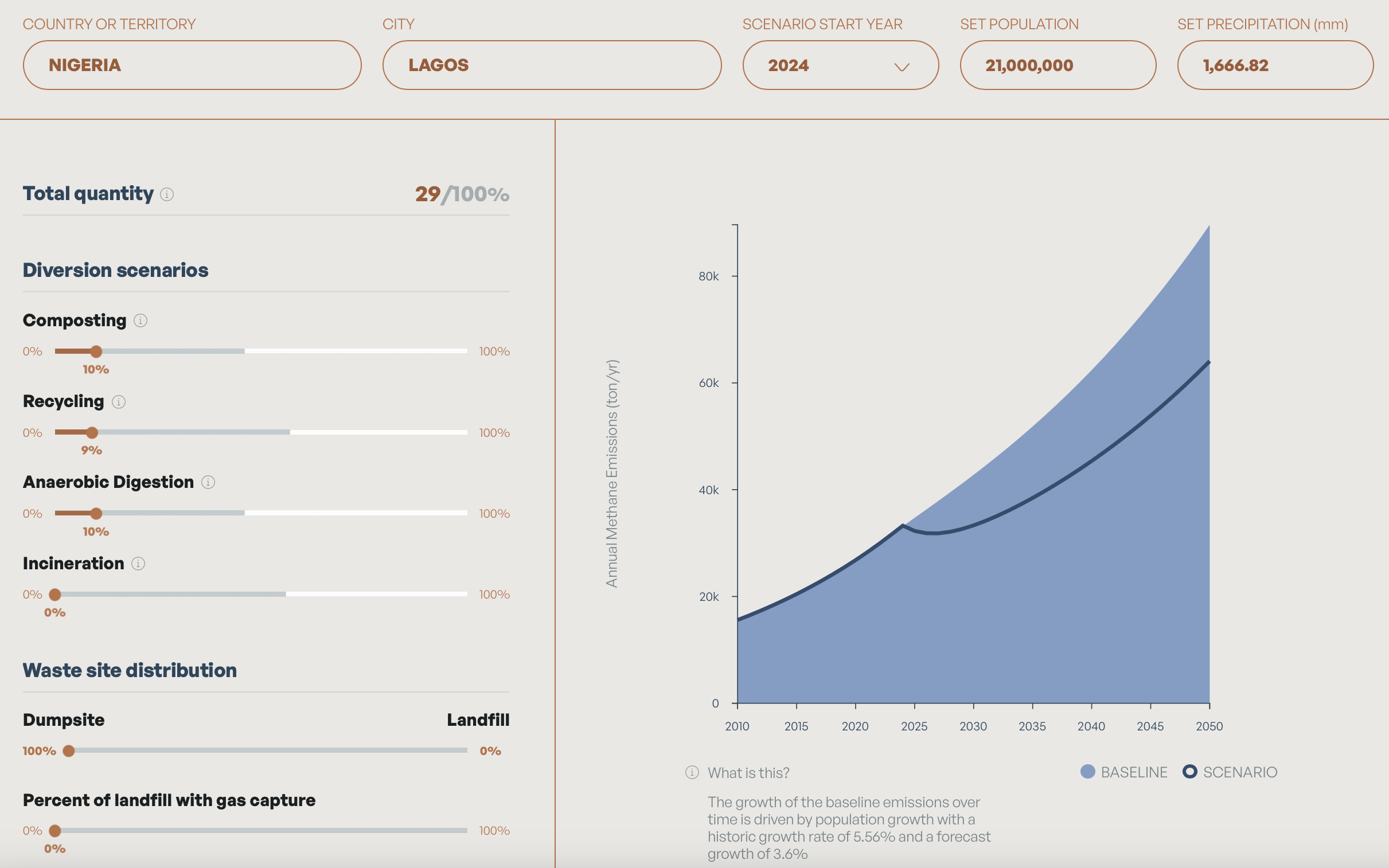Trash bin full of food scraps to make compost - green waste

COP29 Brings Historic Commitments to Reduce Methane from Organic Waste
Advancing climate solutions in the waste sector is critical to slow warming, improve air quality, and protect public health.
Since methane traps significantly more heat per molecule than carbon dioxide — but dissipates from the atmosphere sooner — fast action to cut methane is essential to slow warming over the near term and keep our climate targets within reach. The United Nations climate conference, COP29, highlighted new efforts to address methane pollution from a major but often overlooked source: organic waste.
When organic waste — like food scraps, yard clippings, and cardboard — breaks down in landfills and dumpsites around the world, it generates methane: a climate super pollutant with over 80 times the near-term warming power of carbon dioxide. The waste sector is the third largest source of human-caused methane, and waste generation is on the rise.
But there is good news: proven, cost-effective strategies can unlock major methane reductions. One global study found that existing technology to reduce and recycle organic waste and strengthen emission controls at final disposal sites could curb nearly 90 percent of methane emissions from solid waste.
With this opportunity in mind, the COP29 Presidency included organic waste as a priority initiative for this year’s international climate summit. New announcements inspire hope, and swift implementation is key.
Countries make new commitments to curb methane from organic waste
More than 30 countries, collectively responsible for nearly 50 percent of global methane emissions from organic waste, endorsed the COP29 Declaration on Reducing Methane from Organic Waste. Signatories will set specific targets to reduce waste sector methane in their future nationally determined contributions and develop new policies and programs to achieve those targets. In addition, countries made the following announcements:
- The European Union announced strengthened waste legislation, including obligations to collect biodegradable waste separately, a 10 percent maximum landfilling target by 2035, and an energy neutrality target by 2045 for urban wastewater treatment plants.
- Canada showcased draft regulations expected to cut landfill methane emissions in half by 2030 from 2019 levels. The new regulations place limits on landfill surface methane concentrations and venting, and require the destruction of recovered methane, regular monitoring, and leak repair.
- The United States reiterated its commitment to strengthen emission standards for new and existing landfills to better detect and control methane and other harmful pollutants. In 2024, the US launched its first-ever National Strategy for Reducing Food Loss and Waste and Recycling Organics and announced $117 million in funding from the Bipartisan Infrastructure Law for the waste sector.
- Brazil is finalizing its National Strategy for Organic Waste Management, including plans to reduce food waste. The country also created new incentives for biomethane produced from waste treatment, in addition to a biomethane quality certification system.
- The United Arab Emirates announced new steps to reduce methane emissions from the waste sector, including setting a target of 50 percent landfill diversion by 2025 and 80 percent diversion by 2031.
- Chile highlighted its Reciclo Orgánicos Program, which is expected to reduce 9.5 million tons of CO₂ by 2040 and its National Organic Waste Strategy, which sets a goal of increasing its organic waste recycling from 1 to 66 percent by 2040.
- The United Kingdom reaffirmed its commitment to eliminate biodegradable waste from landfills by 2028.
Why this matters: Focusing on the waste sector is essential to achieve the Global Methane Pledge, limit near-term temperature rise, and avoid dangerous climate tipping points. But we won’t have to wait years to see the impact — quick action means benefits today: since methane is released alongside other harmful pollutants, addressing methane from organic waste will also protect public health, improve air quality, and advance environmental justice.
Methane momentum builds at the subnational level
The Lowering Organic Waste Methane (LOW-Methane) initiative, launched by the US State Department last year at COP28 and supported by several implementation partners including RMI, aims to reduce annual waste sector methane emissions by at least 1 million metric tons by 2030 and unlock over $10 billion in public and private investment by working with 40 subnational jurisdictions. The inaugural cohort, Chile, the Dominican Republic, Indonesia, and Nigeria, led the charge on the commitments to reduce methane emissions from organic waste.

A wheelbarrow of food waste collected at Ketu Market in Lagos, Nigeria. Using this waste as feedstock for composting or anaerobic digestion could divert waste from dumpsites, reduce methane emissions, and promote public health. RMI is currently working in Lagos to assess the viability of converting organic waste to valuable end products like compost and biogas.
At this year’s COP, two subnational jurisdictions from the inaugural cohort, Lagos and Santo Domingo, released their LOW-Methane portfolios identifying priority goals and actions toward achieving the methane reduction targets. These goals include expanding organic waste treatment capacity, closing dumpsites, developing sanitary landfills, strengthening institutions, and providing support to operators. Together, these portfolios could reduce methane emissions by up to 40,800 tons annually compared to baseline projections. This progress demonstrates how subnational jurisdictions can work together with their national government counterparts to drive methane reduction.
US states are also stepping up to address methane pollution from landfills. In 2025, Colorado and California can advance new landfill emissions standards that leverage the latest monitoring technologies and proven best practices to cut planet-warming pollution, improve air quality, and protect communities.
New data will unlock further methane reductions and track progress
The International Methane Emissions Observatory announced it intends to expand the Methane Alert and Response System to the waste sector in 2025, leveraging methane-detecting satellite technology to quickly pinpoint and address leaks at landfills and dumpsites around the globe.

Carbon Mapper detections from Planet Labs’ Tanager-1 satellite show a methane plume at a landfill in Buenos Aires, Argentina, on Oct. 26, 2024. This persistent source was observed emitting multiple days during the month of October.
Recent remote sensing surveys have identified large methane plumes in the waste sector. In the United States, Carbon Mapper has observed methane emissions from hundreds of large landfills by aircraft, detecting significant, often persistent plumes at more than half of the landfills they flew over. And now, the Carbon Mapper Coalition’s first satellite — alongside other remote sensing instruments like MethaneSAT — will provide more frequent, actionable methane data that countries, subnational jurisdictions, operators, and community members can use to prioritize mitigation and track progress against the commitments described above.
What’s next?
The solutions are clear. Keeping organics out of landfills and dumpsites — through waste prevention, food donation, composting, and other organics diversion programs — avoids new methane generation while building healthier food systems, ecosystems, and communities. At the same time, improving methane monitoring and emissions controls at final disposal sites is critical to cut methane quickly from previously buried waste and protect people living nearby.
National, state, and local governments — alongside key private sector and non-governmental partners — all play important roles in turning these COP29 organic waste commitments into real methane reductions. To help with this effort, RMI developed the Waste Methane Assessment Platform (WasteMAP), an open, online platform that aggregates and maps waste methane emissions data — including from methane-detecting satellites.
WasteMAP’s decision support tool shows sizable methane emissions mitigation potential from increased composting and anaerobic digestion in Lagos, Nigeria.
Launched last year, the platform includes case studies from around the world and a decision support tool for policymakers, landfill operators, and other stakeholders to establish baseline methane emissions and model alternative scenarios with improved waste management practices. We hope WasteMAP will continue to help jurisdictions design strong programs and policies that deliver rapid methane reductions from organic waste.
